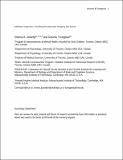Memory engrams: Recalling the past and imagining the future
Author(s)
Josselyn, Sheena A.; Tonegawa, Susumu
DownloadAccepted version (6.847Mb)
Open Access Policy
Open Access Policy
Creative Commons Attribution-Noncommercial-Share Alike
Terms of use
Metadata
Show full item recordAbstract
In 1904, Richard Semon introduced the term “engram” to describe the neural substrate for storing memories. An experience, Semon proposed, activates a subset of cells that undergo off-line, persistent chemical and/or physical changes to become an engram. Subsequent reactivation of this engram induces memory retrieval. Although Semon’s contributions were largely ignored in his lifetime, new technologies that allow researchers to image and manipulate the brain at the level of individual neurons has reinvigorated engram research. We review recent progress in studying engrams, including an evaluation of evidence for the existence of engrams, the importance of intrinsic excitability and synaptic plasticity in engrams, and the lifetime of an engram. Together, these findings are beginning to define an engram as the basic unit of memory.
Date issued
2020-01Department
RIKEN-MIT Center for Neural Circuit Genetics; Picower Institute for Learning and Memory; Massachusetts Institute of Technology. Department of Biology; Massachusetts Institute of Technology. Department of Brain and Cognitive SciencesJournal
Science
Publisher
American Association for the Advancement of Science (AAAS)
Citation
Josselyn, Sheena A. and Susumu Tonegawa. "Memory engrams: Recalling the past and imagining the future." Science 367, 6473 (January 2020): eaaw4325 © 2019 The Authors
Version: Author's final manuscript
ISSN
0036-8075
1095-9203